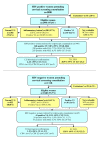Cervical cancer screening by visual inspection in Côte d'Ivoire, operational and clinical aspects according to HIV status
- PMID: 22443255
- PMCID: PMC3328262
- DOI: 10.1186/1471-2458-12-237
Cervical cancer screening by visual inspection in Côte d'Ivoire, operational and clinical aspects according to HIV status
Abstract
Background: Cervical cancer screening is not yet standard of care of women attending HIV care clinics in Africa and presents operational challenges that need to be addressed.
Methods: A cervical cancer screening program based on visual inspection methods was conducted in clinics providing antiretroviral treatment (ART) in Abidjan, Côte d'Ivoire. An itinerant team of midwives was in charge of proposing cervical cancer screening to all HIV-positive women enrolled in ART clinics as well as to HIV-negative women who were attending the Abidjan national blood donor clinic. Positively screened women were systematically referred to a colposcopic examination. A phone-based tracking procedure was implemented to reach positively screened women who did not attend the medical consultation. The association between HIV status and cervical cancer screening outcomes was estimated using a multivariate logistic model.
Results: The frequency of positive visual inspection was 9.0% (95% CI 8.0-10.0) in the 2,998 HIV-positive women and 3.9% (95% CI 2.7-5.1) in the 1,047 HIV-negative ones (p < 10-4). In multivariate analysis, HIV infection was associated with a higher risk of positive visual inspection [OR = 2.28 (95% CI 1.61-3.23)] as well as more extensive lesions involving the endocervical canal [OR = 2.42 (95% CI 1.15-5.08)]. The use of a phone-based tracking procedure enabled a significant reduction of women not attending medical consultation after initial positive screening from 36.5% to 19.8% (p < 10-4).
Conclusion: The higher frequency of positive visual inspection among HIV-positive women supports the need to extend cervical cancer screening program to all HIV clinics in West Africa. Women loss to follow-up after being positively screened is a major concern in cervical screening programs but yet, partly amenable to a phone tracking procedure.
Figures

References
-
- Ferlay J, Shin HR, Bray F, Forman D, Mathers C, Parkin DM. GLOBOCAN 2008, Cancer Incidence and Mortality Worldwide: IARC CancerBase No. 10 [Internet] Lyon, France: International Agency for Research on Cancer; 2010. http://globocan.iarc.fr last accessed 01/15/12.
-
- Global HIV/AIDS response: epidemic update and health sector progress towards universal access: progress report 2011. Geneva, UNAIDS; http://whqlibdoc.who.int/publications/2011/9789241502986_eng.pdf last accessed 01/15/12.
-
- Brinkhof MW, Boulle A, Weigel R, Messou E, Mathers C, Orrell C, Dabis F, Pascoe M, Egger M. Mortality of HIV-infected patients starting antiretroviral therapy in sub-Saharan Africa: comparison with HIV-unrelated mortality. PLoS Med. 2009;6(4):e1000066. doi: 10.1371/journal.pmed.1000066. - DOI - PMC - PubMed

